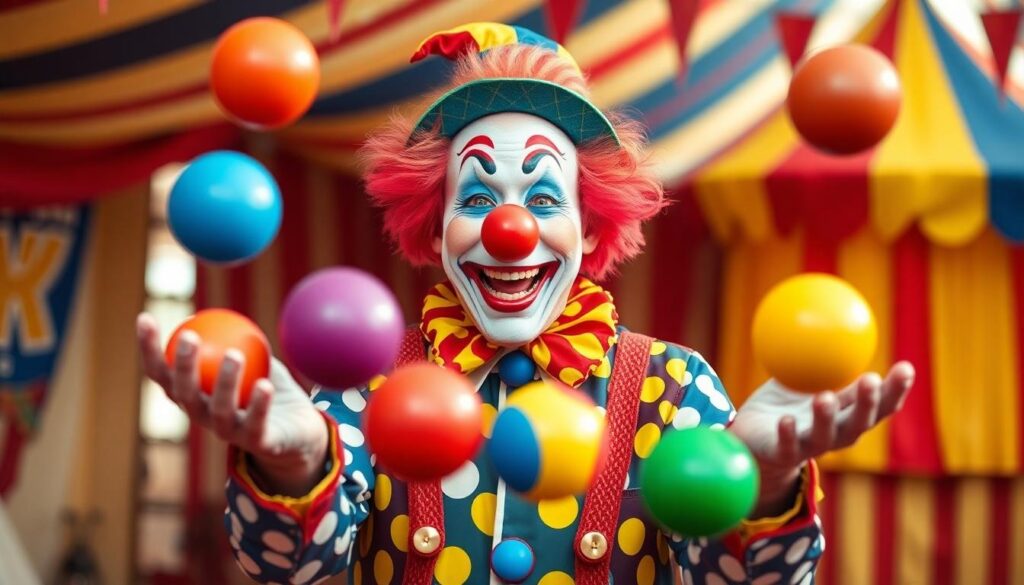Laughter is the best medicine, and what better way to get your daily dose than with some hilarious clown jokes? We’ve gathered the funniest, most side-splitting clown humor that’ll have you chuckling all day long. Whether you’re planning a circus-themed party or just need something to brighten your day, these jokes are perfect for any occasion.
We all remember encountering clowns as children—those colorful characters with painted smiles, oversized shoes, and a talent for making us giggle. Now it’s time to relive those moments with our comprehensive collection of clown jokes that’ll appeal to both kids and adults. From witty one-liners to longer setups with punchlines that’ll knock your rainbow wig off, we’ve got everything covered in our laugh-out-loud compilation.
10 Hilarious Clown Jokes That Will Have You Rolling with Laughter
- Why don’t clowns ever win the lottery? Because when they get the numbers, they always juggle them around! We’ve noticed this joke always gets a giggle from both adults and kids at parties.
- What happened when the clown fell into the washing machine? He came out feeling brand new but a little washed up! Everyone loves this classic play on words that combines laundry mishaps with career struggles.
- How many clowns does it take to change a lightbulb? Ten—one to hold the bulb and nine to rotate the ladder! This twist on the traditional lightbulb joke format perfectly captures clown car chaos energy.
- What do you call a clown who doesn’t make anyone laugh? A politician! Political humor always works well when delivered with a colorful wig and oversized shoes.
- Why was the clown sad after visiting the doctor? The doctor told him he was suffering from “terminal seriousness”! Medical humor with a clownish twist tends to break even the iciest audiences.
- What’s a clown’s favorite type of exercise? Squirt-gun workouts and running gags! Puns about clown props connect directly to visual comedy elements we all remember from childhood.
- Why did the clown always carry around a pencil? In case he needed to draw attention! This joke works particularly well with visual performers who can pantomime the action.
- What do you call a clown in jail? Silicon! Because he’s a silly con! Wordplay jokes showcase the linguistic cleverness behind great clown humor without requiring physical comedy.
- Why don’t clowns ever go bald? Because their hair is already funny! Simple observational humor about clown appearances tends to land easily with audiences of all ages.
- What’s a clown’s favorite dessert? Funny cake with whipped cream—in your face! Ending with a physical comedy reference brings everything full circle to what makes clown humor timeless.
Why Clown Jokes Never Get Old: The Psychology Behind Circus Humor
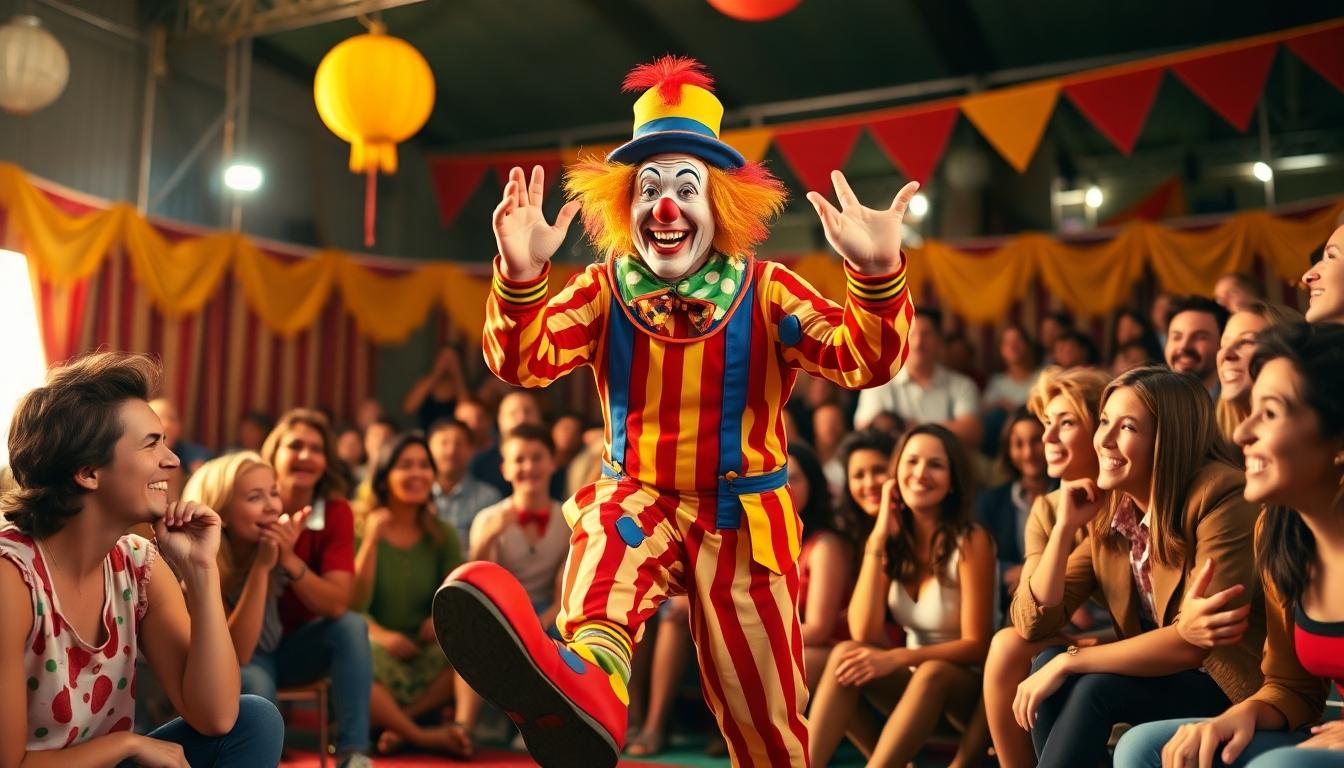
Clown jokes maintain their enduring popularity because they masterfully create humor from unexpected situations while tapping into our emotional core. The fascinating “sad clown paradox” reveals how many comedians use humor as a coping mechanism for their inner turmoil, creating performances that both captivate and resonate with audiences. Through their exaggerated antics and colorful personas, clowns possess a unique ability to lighten tense moments and provide much-needed comic relief during stressful situations by leveraging humor’s contagious nature.
The Universal Appeal of Clown Comedy
Clown comedy crosses cultural boundaries thanks to its primarily non-verbal and visually captivating nature. The physical aspect of clown performances eliminates language barriers, making their humor accessible to people worldwide regardless of native tongue. Slapstick routines featuring exaggerated falls, silly props, and visual gags can trigger laughter from audiences of all backgrounds. Children and adults alike connect with the simple yet effective physical comedy that clowns employ, creating a shared experience that transcends age, culture, and social status.
How Clown Jokes Break Social Barriers
Clown jokes serve as powerful tools for breaking down social barriers in multiple ways:
- Inclusion: Clowns routinely make themselves the target of jokes, encouraging others to laugh at their own imperfections and feel more welcome in social gatherings.
- Tension Relief: When anxiety fills a room, clowns introduce humor that creates a collective experience, effectively uniting people while simultaneously reducing stress levels.
- Universal Language: Physical comedy and exaggerated facial expressions enable clowns to communicate humor effectively even in diverse multicultural environments where verbal jokes might fall flat.
Classic Clown Jokes That Have Stood the Test of Time
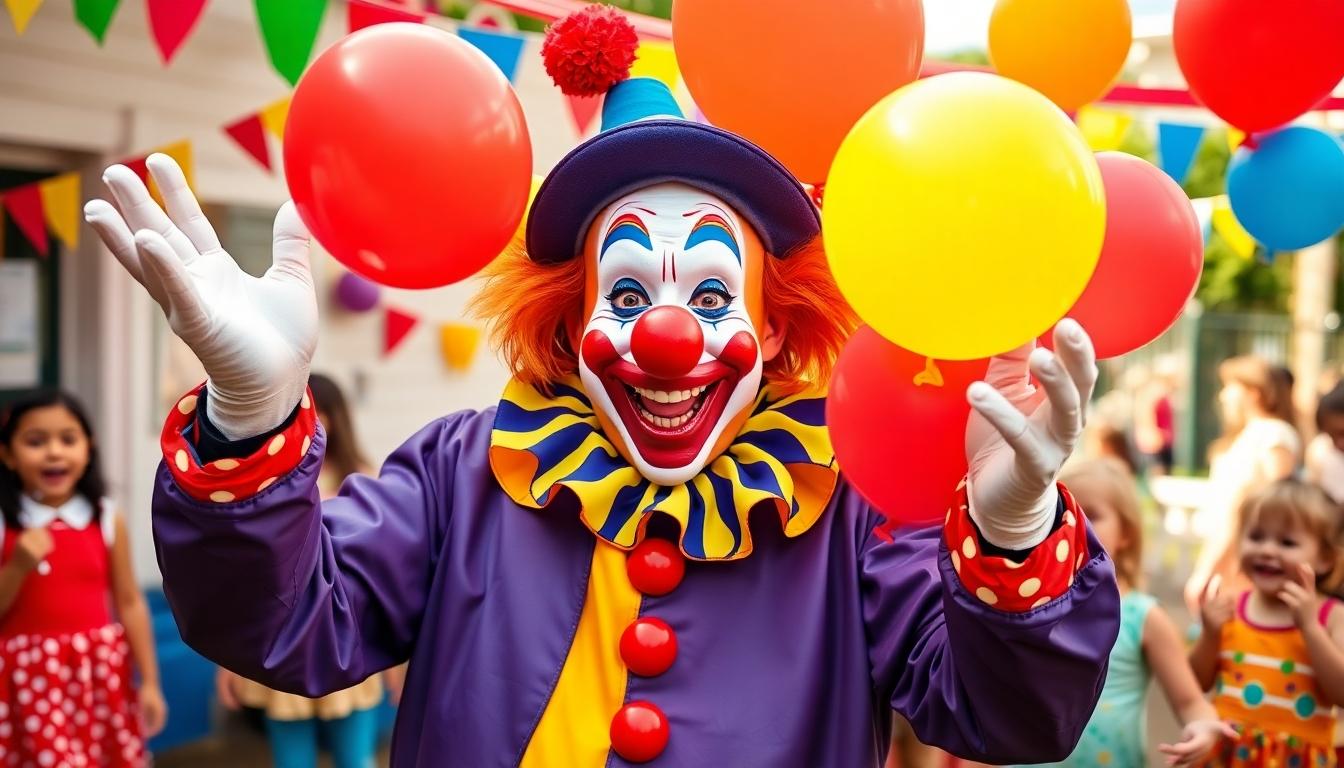
Classic clown jokes have delighted audiences for generations with their playful humor and universal appeal. These timeless jests capture the essence of clown comedy that continues to bring smiles to faces young and old.
- Why did the clown bring a ladder to the gym? He was trying to reach new heights in his workout.
- What do you call a clown who’s lost his nose? Nobody nose for sure.
- Why did the clown always carry a book? Because he loved a good punchline.
- How do clowns make phone calls? They use their “funny-bone phones.”
One-Liners That Always Get a Laugh
One-liners deliver instant comedy punches that work perfectly in almost any situation. These quick clown quips are ideal for breaking the ice or lightening the mood with minimal setup.
- What did the clown say to the tightrope walker? “You’re walking a fine line… and I’m here for it!”
- Why did the clown bring a ladder to the bakery? To reach the top-tier jokes—freshly baked.
- How do clowns keep their pants up? With a “belt-er” of a joke.
Silly Punchlines for Any Occasion
Silly punchlines work wonderfully across various events and gatherings, making them versatile additions to your comedy arsenal. These jokes often rely on clever wordplay or unexpected twists that catch listeners off guard.
Knock-knock jokes adapt beautifully to clown themes, creating opportunities for interactive comedy moments with your audience. The familiar format combined with clown-related surprises makes these jokes accessible to people of all ages.
Wordplay jokes featuring clown terminology offer another layer of humor that showcases wit and creativity. These puns transform ordinary conversations into delightful exchanges by leveraging clown-related terms in unexpected contexts.
Family-Friendly Clown Jokes to Share with Kids
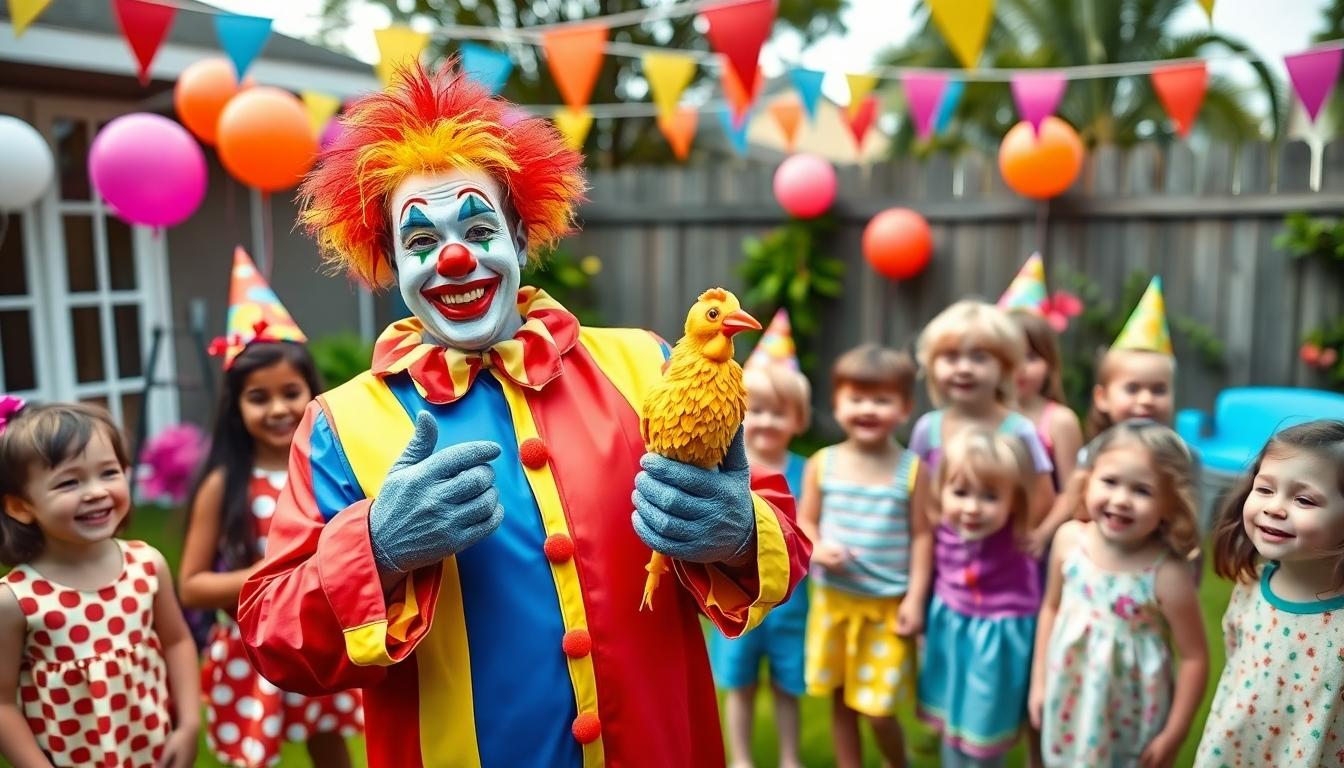
Clean Humor for Birthday Parties
Birthday parties become instantly more entertaining with the right clown jokes in your repertoire. Kids love classics like “Why did the clown cross the road? To get his rubber chicken!” which creates immediate giggles without any inappropriate content. “How do clowns cook their eggs? Funny side up!” serves as another perfect example that can be incorporated into party games or printed on cupcake toppers for an interactive experience. These light-hearted quips create a festive atmosphere while keeping the humor accessible for all ages. Party planners often use these jokes as icebreakers or include them in themed activities to enhance the celebratory mood.
Jokes That Teach While They Entertain
Clown humor cleverly introduces children to linguistic concepts through entertaining wordplay. Riddles like “What’s pink and stuck between an elephant’s toes? Slow clowns” encourage kids to think creatively while laughing. “Why was the clown’s mortgage denied? He couldn’t afford the clown payments!” introduces financial concepts through humor that children can understand. Material-based puns such as “What material are clown costumes made of? Poly-jester!” help kids learn about wordplay while staying thoroughly entertained. Animal-themed jokes including “What did the tiger call the clown? A happy meal!” combine familiar concepts in surprising ways that delight young audiences. Jokes featuring exaggerated scenarios like “What happened when two clown cars crashed? Forty people dropped their snacks!” foster imagination without relying on crude humor, making them perfect for family gatherings.
Dark Clown Jokes for Adults Only

Enter the shadowy big top where clown humor takes a sinister turn. These jokes aren’t for the faint of heart or young audiences—they explore the darker side of circus comedy that plays with fear, taboo subjects, and twisted punchlines.
When Circus Humor Takes a Twisted Turn
Dark clown humor thrives on subverting innocence through adult-themed wordplay and existential themes. Traditional circus comedy gets flipped on its head when it incorporates elements of enforced performance, where humor becomes weaponized in disturbing contexts. Many of these jokes rely on the stark contrast between childlike circus imagery and violent or dreadful themes. For example, a dark twist on the Pennywise character: “How did the clown count his money? Pennywise.” This pun works on multiple levels, referencing both the terrifying character from Stephen King’s universe and making a clever wordplay.
Existential absurdity also features prominently in twisted circus humor, with jokes like: “How do you cheer up a sad clown? Take him to an orthopedic surgeon to fix his funny bone.” These jokes often contain layers of meaning, using gallows humor to critique power dynamics and human suffering. Unlike traditional clown jokes that focus on simple puns about feeling “funny,” dark iterations amplify discomfort by balancing comedy with underlying horror.
Jokes That Play on Coulrophobia
Coulrophobia-driven jokes deliberately exploit the common fear of clowns, creating macabre comedy through disturbing twists. These jokes rely on incongruity by pairing childlike clown imagery with violence or existential dread. Cannibal-centric humor represents a popular subset, with jokes like “Why don’t cannibals eat clowns? Because they taste funny” delivering unexpected punchlines that play on multiple meanings of “funny.”
Morbid punchlines create another dimension of coulrophobia-based humor, as seen in jokes such as “What’s left of a clown after a bear attack? Just his funny bone.” This type of humor works by creating psychological tension between the lighthearted circus industry and grim reality. The effectiveness of these jokes stems from their ability to transform familiar, innocent clown tropes into vehicles for exploring darker human experiences. Many coulrophobia jokes deliberately create unease, using shock value to break social taboos while maintaining just enough humor to keep the joke functioning as comedy rather than pure horror.
International Clown Jokes from Around the World

Clown humor transcends geographical boundaries while taking on unique characteristics that reflect local traditions and cultural values. Let’s explore how clown comedy varies across different cultures and the universal elements that connect them all.
Cultural Differences in Clown Humor
The humor styles of clowns differ dramatically from one culture to another, creating a rich tapestry of comedic traditions. In Java, the Punakawan clowns interrupt sacred Ramayana epic performances with ironic commentary and absurd jokes, skillfully blending satire with traditional storytelling rituals. North American Heyokas from Lakota traditions employ fascinating reverse logic in their performances—riding horses backward and wearing clothes inside-out—to provoke laughter while facilitating community healing. British Pantomime clowns emphasize audience interaction and slapstick humor, creating a theatrical experience that’s uniquely captivating. Latin American Payasos merge European clowning techniques with indigenous performance styles, often utilizing physical comedy during festivals and celebrations.
The concept of gelotophilia—enjoying being laughed at—is particularly prominent in cultures where clowns like the Heyokas embrace ridicule for communal benefit. Societies that place stronger emphasis on personal dignity tend to restrict more overt forms of mockery in their clown traditions. European clown history reveals interesting cultural appropriations, with performers historically adopting exoticized attire such as Hindu turbans to heighten their comedic strangeness, reflecting colonial-era fascination with the “other.” Language-exact humor creates additional differentiation between clown traditions, with puns and wordplay varying significantly across linguistic boundaries.
Universal Clown Themes Across Borders
Even though their cultural variations, clowns worldwide share the fundamental characteristic of transgressing social norms through exaggerated behavior, mockery of authority figures, and comical physical mishaps. They function as social mirrors in nearly every culture, offering critiques of hypocrisy and rigid hierarchies through the disarming medium of humor. Ritualistic laughter, documented in Brazilian Nambikwara and Hopi ceremonies, highlights clowns’ universal role in facilitating communal catharsis across continents and centuries.
The archetype of the “trickster”—a character who is simultaneously foolish and wise—appears consistently in both indigenous and modern clowning traditions. This dual nature allows clowns to deliver profound truths through seemingly simple jokes, bridging ancient wisdom traditions with contemporary humor. The physical nature of clown comedy often transcends language barriers, making certain elements of clown humor instantly recognizable regardless of cultural context. Traditional props like oversized shoes, colorful wigs, and red noses have become international symbols of clown performance, creating visual shorthand that audiences worldwide understand as invitations to laughter.
Circus Professionals’ Favorite Inside Jokes
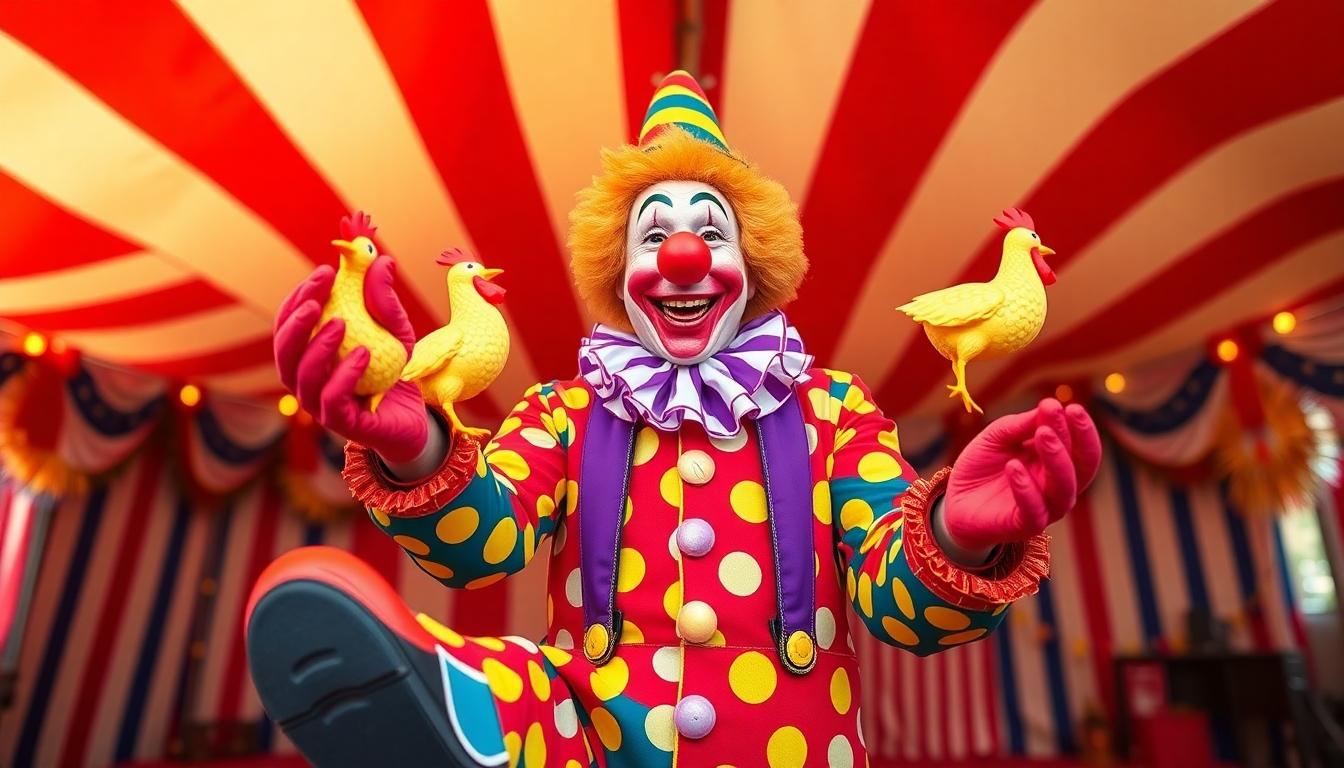
What Real Clowns Laugh About
Professional clowns have their own unique brand of humor that often goes unnoticed by the general public. They frequently joke about occupational hazards that only insiders truly understand. “Why shouldn’t you use the toilet after a clown? It smells funny!” represents the self-deprecating humor clowns use to poke fun at their sometimes chaotic performances. Another favorite among professionals asks, “Why did the clown make a rubber chicken his sidekick?” – a reference to the time-honored traditions of physical comedy that have defined the profession for generations. Circus professionals also enjoy financial wordplay, with “CLOWN payments” serving as a humorous acknowledgment of the financial struggles many performers face throughout their careers. These jokes reflect the distinctive culture of circus life, combining wordplay, absurdity, and irony that resonates specifically with those who wear the makeup and oversized shoes.
Industry Humor You Won’t Hear in the Ring
Behind the colorful curtains of the circus, professionals share jokes that address the logistical challenges of their nomadic lifestyle. “Why did the clown take a holiday? The circus got a bit in-TENTS!” perfectly captures the stress associated with constant tent setup and teardown that circus performers endure. Creative process humor also thrives backstage, exemplified by lines like “Why did the clown always carry a pencil? To draw a crowd!” which cleverly highlights the audience engagement tactics that every successful clown must master. Wordplay dominates the circus comedy industry, with professionals regularly exchanging puns like referring to “laughing stock” when discussing OXO cubes. Self-referential humor about career longevity appears in jokes about having “big shoes to fill” after retirement, while prop-based comedy remains essential to the clown tradition, with rubber chickens and exaggerated objects serving as staples for physical gags. These insider jokes create a sense of camaraderie among circus professionals who understand the unique joys and challenges of entertaining audiences under the big top.
How to Tell a Great Clown Joke: Tips from Comedians

Professional comedians have perfected the art of clown humor through years of practice. We’ve gathered their insider secrets to help you deliver clown jokes that will leave your audience in stitches.
The Rule of Three
The Rule of Three stands as one of comedy’s most powerful techniques. Professional clowns use this method by repeating an action or gesture exactly twice, then introducing a surprising twist on the third attempt. For example, a clown might try to sit on a chair successfully twice, then fall dramatically on the third try. This technique works because it establishes a pattern that creates anticipation, making the final unexpected deviation much funnier.
Clocking the audience proves essential when delivering any clown joke. This technique involves making natural eye contact with your audience to create a sense of shared experience. When you “clock” the audience during your performance, you’re not simply looking at them but inviting them into the joke as participants rather than mere observers.
Rhythm and repetition serve as the backbone of effective clown comedy. Your timing must be precise to maximize laughs, using repetitive elements to build comedic tension. Many successful clown routines incorporate variations on a repeated theme, allowing the audience to become familiar with a pattern before surprising them with clever deviations.
Timing and Delivery Techniques
Anticipation and build-up transform ordinary jokes into memorable performances. Professional clowns extend moments deliberately, using prolonged actions and exaggerated reactions to let audience anticipation grow. The longer you can sustainably build tension before delivering your punchline, the more satisfying the release of laughter becomes.
Contrast and surprises form the heart of effective clown humor. Your joke should include unexpected twists that catch the audience off guard. For instance, setting up a scenario where the audience expects one outcome but receives something completely different creates a perfect environment for hearty laughter. This contrast between expectation and reality lies at the core of classic clown comedy.
Using Physical Comedy to Enhance Your Jokes
Exaggerated actions turn simple tasks into comedy gold. Clowns make mundane activities hilarious by approaching them with outsized reactions and movements. Rather than simply putting on a hat, a skilled clown first examines it thoroughly, looks to the audience with confusion, attempts to wear it incorrectly, and finally discovers its proper use with exaggerated delight.
Physical misadventures add an element of slapstick that audiences consistently enjoy. Incorporating well-executed trips, falls, or other physical mishaps into your routine creates visual comedy that transcends language barriers. These physical elements should appear spontaneous while actually being carefully choreographed to ensure both safety and maximum comedic effect.
Modern Clown Jokes for Today’s Audience
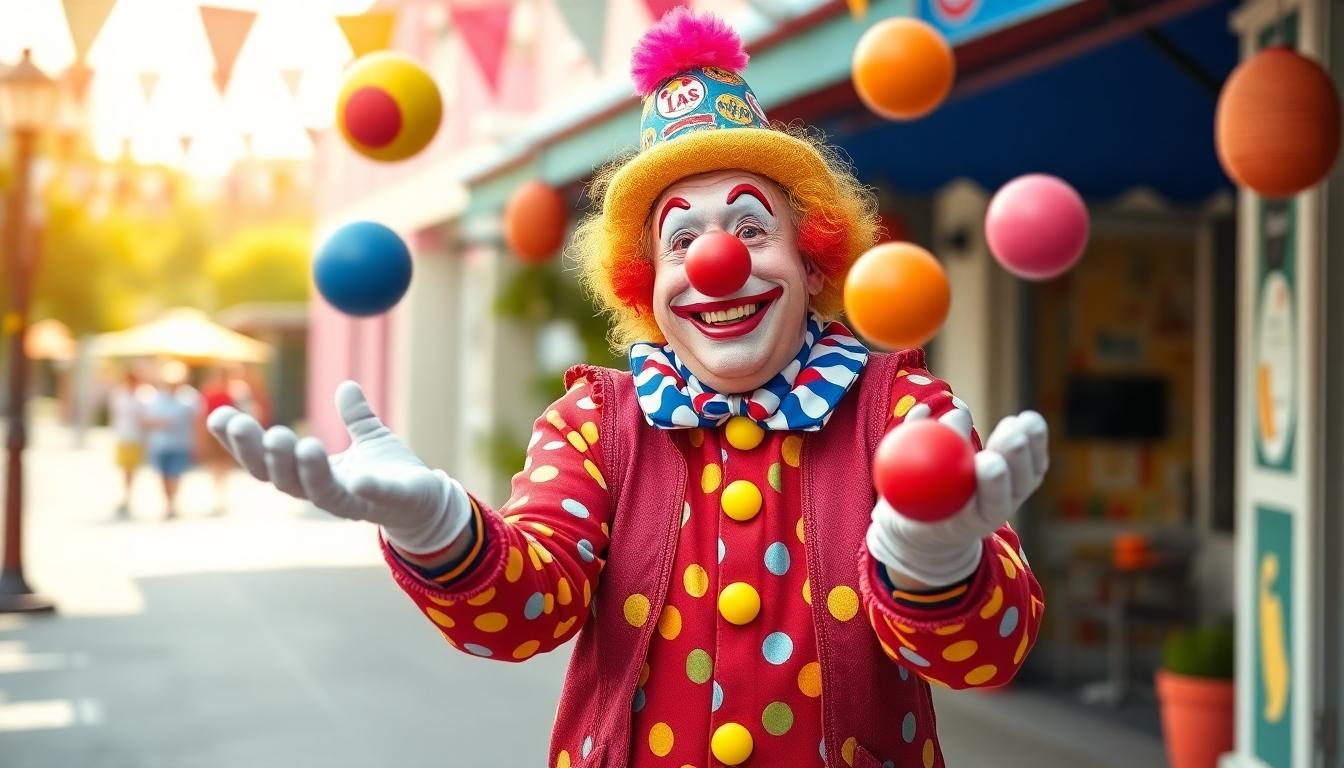
In modern digital era, clown humor has evolved to incorporate contemporary elements while maintaining its timeless appeal. We’ve collected some freshly updated jokes that resonate with modern audiences.
Social Media-Ready Quips
- Why did the clown get turned down for a mortgage?
He couldn’t afford the CLOWN payments!
- What do clowns fill their cars with?
Laughing gas!
- Why shouldn’t you use the toilet after a clown?
It smells funny!
- Why was the clown sad?
She broke her funny bone!
- How do you fight a gang of clowns?
Go for the JUGGLER!
Contemporary References in Classic Setups
- I’m going to send a clown to deliver flowers to my wife.
Will she think that’s a romantic jester?
- Why don’t cannibals eat clowns?
Because they taste funny.
- What’s the funniest fish?
A clownfish… Juggle fever.
- How did the clown write his jokes?
He jest put pun to paper!
- Why did the clown go to the doctor?
He was feeling funny.
Conclusion: Why We’ll Never Stop Laughing at Clown Jokes
Clown jokes have stood the test of time for good reason. They connect us through universal humor that transcends age boundaries cultural differences and language barriers.
From kid-friendly punchlines to insider circus humor and even darker adult jokes these colorful characters offer something for everyone. We’ve seen how clown comedy serves as both entertainment and a social mirror reflecting our shared human experiences.
Whether you’re telling these jokes at a birthday party sharing them online or using them to break the ice clown humor continues to evolve while maintaining its timeless appeal. So next time you need a laugh remember that behind every red nose and oversized shoe lies a joke waiting to brighten your day.
Frequently Asked Questions
Why do people find clown jokes funny?
People find clown jokes funny because they combine physical comedy, surprise, and absurdity. Clown humor works on multiple levels by using exaggerated expressions and actions that create visual comedy. The “sad clown paradox” also plays a role, where humor emerges from the contrast between a clown’s cheerful appearance and underlying melancholy. This combination of elements creates a universal appeal that transcends language barriers.
Are clown jokes appropriate for children?
Yes, many clown jokes are perfect for children! Family-friendly clown jokes use clean humor and silly punchlines that kids easily understand, like “Why did the clown cross the road? To get his rubber chicken!” These jokes can enhance birthday parties, serve as icebreakers, and even teach children linguistic concepts through wordplay, encouraging creativity and imagination while keeping the atmosphere light and fun.
What makes a good clown joke?
A good clown joke incorporates timing, rhythm, and often follows the Rule of Three (establishing a pattern before introducing a surprising twist). The best clown jokes balance anticipation with unexpected punchlines and may include physical comedy elements. Professional comedians recommend engaging your audience, using exaggerated actions, and maintaining confident delivery. Both simplicity and creativity are key ingredients in crafting memorable clown humor.
Are there different types of clown jokes around the world?
Yes, clown humor varies significantly across cultures while maintaining universal appeal. Each region has unique traditions – from Java’s satirical Punakawan clowns to the audience interaction of British Pantomime. Despite these differences, certain themes remain consistent worldwide: clowns as social critics, the trickster archetype, and physical comedy. These cultural variations demonstrate how clown humor adapts while continuing to connect people through laughter.
Do professional clowns have their own insider jokes?
Absolutely! Professional clowns share a unique brand of insider humor addressing the quirks of their profession. These jokes reference occupational hazards, performance mishaps, and circus life logistics with lines like “Why did the clown take a holiday? The circus got a bit in-TENTS!” This specialized humor creates camaraderie among professionals and reflects the distinctive culture of circus performers, combining wordplay, absurdity, and industry-specific references.
What are dark clown jokes?
Dark clown jokes are adult-oriented humor that explores the sinister side of clown imagery. These jokes deliberately flip traditional circus comedy by incorporating taboo subjects, existential themes, and references to horror characters. They often play on coulrophobia (fear of clowns) and create psychological tension between innocent clown imagery and grim realities. This subgenre transforms familiar tropes into vehicles for exploring deeper human experiences while balancing comedy with discomfort.
How have clown jokes evolved in modern times?
Modern clown jokes have adapted to contemporary sensibilities while preserving traditional comedy elements. Today’s clown humor incorporates current references, technology themes, and social media-ready quips that resonate with new audiences. Jokes about clowns dealing with modern problems (like mortgages or smartphone troubles) refresh classic setups. This evolution ensures clown humor remains relevant while maintaining its timeless qualities of physical comedy, wordplay, and visual humor.
Can clown jokes help children develop language skills?
Yes! Clown jokes can be excellent tools for developing children’s language skills. The wordplay, puns, and riddles in clown humor introduce children to linguistic concepts in an entertaining way. When kids encounter jokes like “What do you call a clown who’s lost his nose? Smell-less!” they engage with multiple meanings of words, building vocabulary and critical thinking. This playful approach to language makes learning fun and encourages creative expression.

